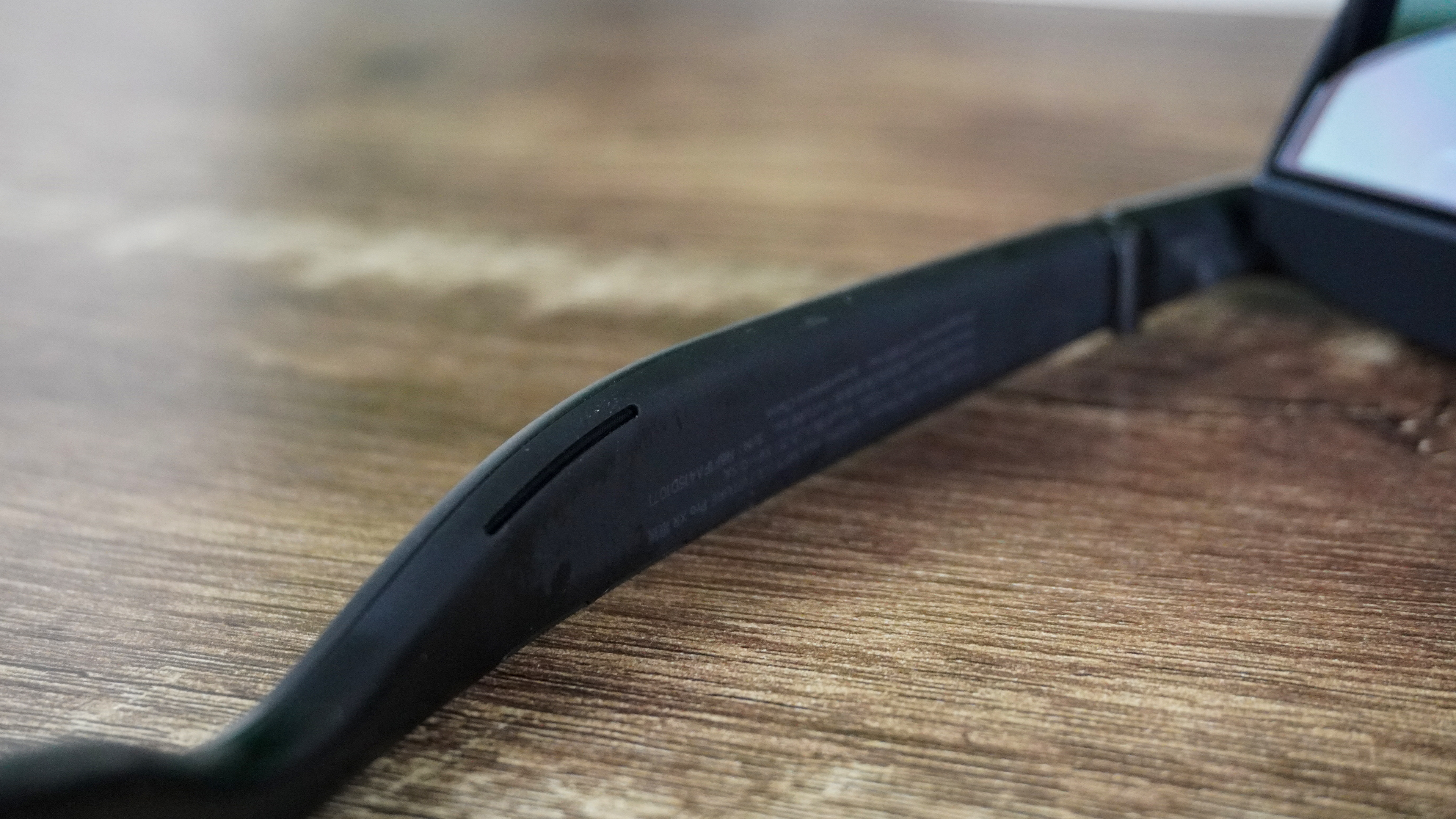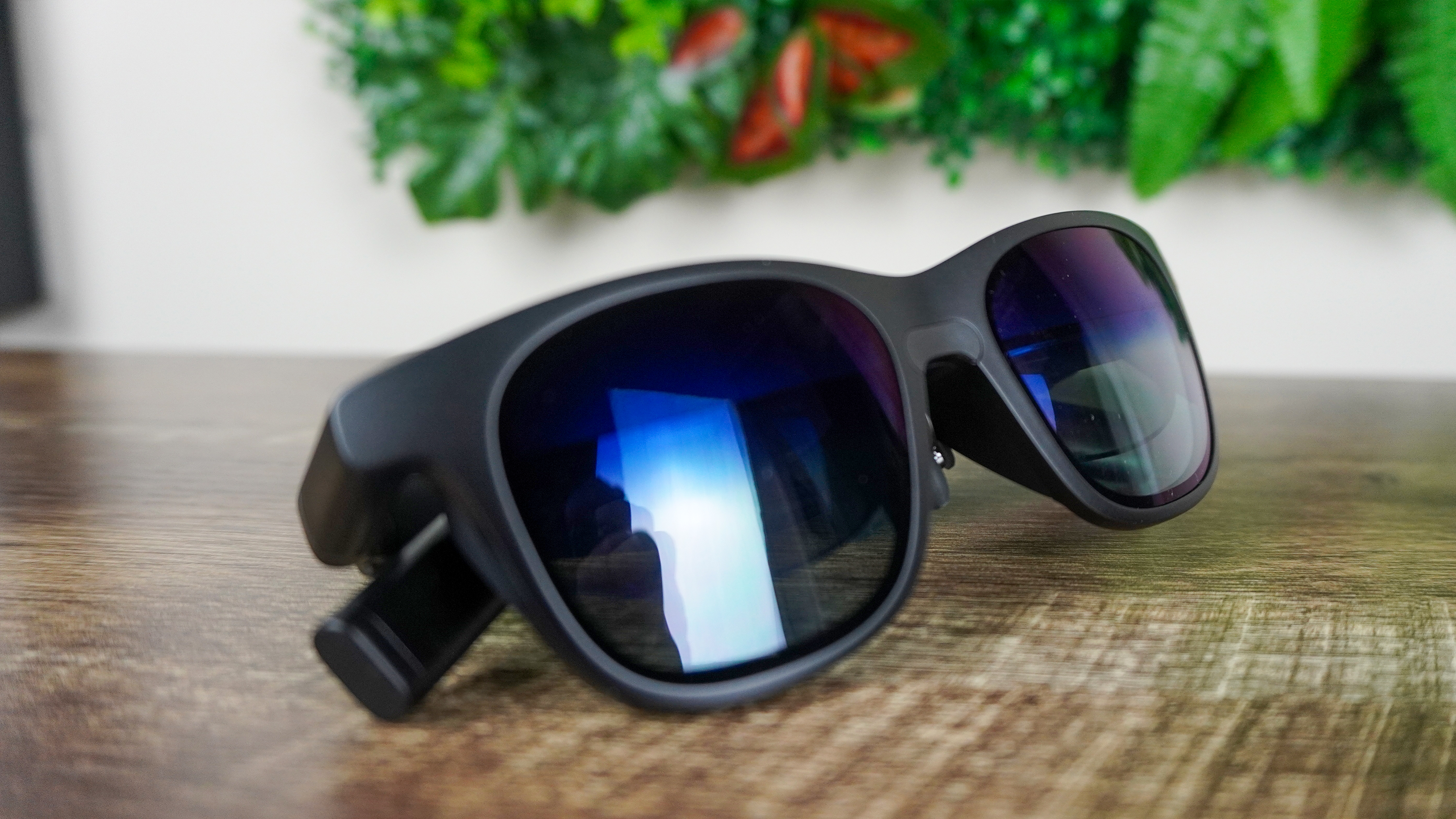Tom's Guide Verdict
The Viture Pro XR specs take the whole AR glasses category to a new level with impressive (and adjustable) display tech, and a ton of software smarts to turn them into an amazing gaming/spatial computing counterpart. If you can afford that steep price of entry, you’re getting the best right now.
Pros
- +
The Micro-OLED display tech is so gorgeous
- +
Electrochromic film is shockingly effective
- +
Lightweight, comfortable and premium design
- +
Hardware 🤝 Software is unmatched
Cons
- -
Expensive for full experience
- -
Sound is on the quiet side
- -
Viewing angle limitation can still be distracting
Why you can trust Tom's Guide
As someone who regularly travels, I’ve been on the hunt for the best pair of AR glasses for a long time. At a fundamental level, being able to sit upright to use my Steam Deck or M3 Pro MacBook Pro and look straight ahead, rather than crane my neck over to see the screen has eliminated any spinal pain.
Plus, it stops any screen peepers sitting next to you (yes, I’m talking about you, Sam in seat 35D on the way to Dubai — I did warn you I’d mention you for staring at my emails) getting a look-in.
Up until this point, that has been the Xreal Air 2 Pro, which brought great tech and a top notch software synergy that allowed these to start bridging the gap between what these specs can do and the full spatial computing experience of a VR headset. Well, that is until now, as the Viture Pro has officially taken its place as the best premium AR glasses.
Why is that? Well there are a ton of reasons from the premium, comfortable design and improved Micro-OLED tech to the Myopia adjustability and suite of products to really make the most of what these glasses can do. But for my own experience, I’d narrow it down to two things that tipped me over the edge:
- The screen: That equivalent of a 135-inch screen with 120Hz refresh rate has zero blurry edges, an impressive brightness and gorgeous color reproduction
- The software: Outside of using these for gaming, the SpaceWalker app is a revelation for multi-screen spatial computing (if slightly buggy at times) — packing ease of use and optimizations to expand what your laptop is capable of on-the-go
Of course, this is Viture. So to get the full experience using the Pro Mobile Dock and a controller to play to your heart’s content is going to cost you a fair bit. The glasses themselves are $549 ($100 more than Xreal Air 2 Pro), and the full suite of hardware to unlock every feature is north of $700.
But when you think about what these offer, and you are someone who makes the most of these features while out and about regularly, this is a price worth paying — especially when you’re unlocking some features that the Apple Vision Pro touts for a fraction of the cost.
Viture Pro XR Glasses: Cheat Sheet
- What is it? These are a pair of AR glasses. Viture calls them XR glasses, which is certainly a feature unlocked by the software. But at their core, these are AR specs.
- Who is it for? Primarily, people who are regularly travelling are going to make the most of these. But I found myself gaming/working on the couch at home using these too, so the use cases are pretty vast!
- How much does it cost? This is a complex question. The glasses themselves are $549 (discounted to $459 right now), but to get the most out of it (including compatibility with Nintendo Switch), you’ll need the $160 mobile dock and the $50 8BitDo Bluetooth controller. As an early offer, you can pick these up in a bundle for $588, but you can start to see how these prices start to creep up for the full set of features.
- What is it like to use them? Simply put, a joy. The 135-inch simulated screen in front of you is bright, colorful and fluid, they are lightweight and comfortable for hours of usage, and the SpaceWalker app unlocks spatial experiences you’d enjoy on Apple Vision Pro at 1/10th the cost.
- Any problems? In my time using these, two problems came up. First, the audio from the built-in speakers is pretty quiet and tinny. And second, as I was trying to explain above, the price can shoot up when grabbing some essential accessories.
Viture Pro XR Glasses: Specs
| Display | Sony Micro-OLED, 135-inch virtual screen with 1080p resolution, up to 1000 nits of perceived brightness, up to 120Hz refresh rate, adjustable for Myopia |
| Audio | Dual speakers tuned by Harman |
| Price | $549 |
| Dimensions (when open) | 5.8 x 6.8 x 1.9 inches |
| Weight | 2.8 ounces |
Viture Pro XR Glasses: The ups
So you get it out the box, pick the right nose pad from a choice of four to fit on your face, download the app and plug it in. From the get-go, I was mesmerized.
Get instant access to breaking news, the hottest reviews, great deals and helpful tips.
That display, though

It’s been jaw-dropping to see how much the display tech in AR glasses has come along over just a couple of years, and Viture is taking another step forward with Sony Micro-OLED tech that is bright, crispy, colorful and super fluid.
At 120Hz, this 135-inch virtual screen is buttery smooth with impressive vividness and deep contrast — perfect for an all-encompassing gaming experience on those long haul flights.
Viture don’t specify the viewing angle of this, but in comparing with the Xreal Air 2 Pro, its looking similar so I’d chalk this up to roughly 50 degrees. Of course that’s a little limited (more on that later), but in the vast majority of use cases, this won’t be a problem.

On top of that, the Myopia adjustment dials make this impressively customizable to any near-sightedness, and the electrochromic film atop the front of the glasses is next level. Seriously.
You can get a lens shade, but I didn’t have to use it once, as pretty much everything in the background is blocked out. Plus the shade they gave me is a little creepy to say the least!
Now we’re getting somewhere on the design front

One obstacle of AR glasses hardware is the size of it. Don’t get me wrong, it’s not a gigantic VR headset, but no matter how sneaky the aesthetic is in mimicking a pair of Wayfarers, they are a little larger than life. It does draw double-takes from people who walk past your aisle on the plane to be wearing something that looks akin to the spy glasses you’d buy at the Scholastic book fair.
Does Viture completely fix this problem? No, but the company is well on the way with its Pro specs. There is still some thickness in the actual lenses, to house the display tech and prisms, but all in all, these are a slick pair of shades — with a soft touch finish and 80g weight to be comfortable for many hours of use.

Oh, and shout-out to the magnetically-attached cable too. I can’t begin to tell you the moments of frustration where a pair of glasses have been yanked off my face because of a rigid USB-C connection, so to see this remedied is great.
Sublime software integration

Spatial computing is a thing, and AR glasses have been the most surprising devices to be on the forefront of this. Don’t get me wrong — it’s not like what you get in something like the Apple Vision Pro, but that’s like comparing apples and oranges. Of course the VR headset with a far wider field of view is going to give you that fuller immersion.
But that’s not to say these specs aren’t getting close with software trickery for a lower price, and the Viture Pro speed ahead of the pack with SpaceWalker. The multi-display options are vast and give you a marked improvement in productivity on-the-go by giving you a whole host of choices to cater to your flow.
Looking for a simple dual display array? Sure thing! How about a 21:9 ultrawide? You got it. What about a triple display with two vertical screens? It’s all good. This setup has been an absolute joy to use on long journeys — snapping your entertainment to one screen, while working on the other and keeping track of data on the right.

Even better is the fact that all of this is plug-and-play. You just connect the glasses, open the app, choose your screen layout and you’re off to the races. It’s not completely fault-free, as I came across a couple bugs like apps disappearing when dragging them to other screens. But one swift unplug/replug later fixed that right up. That is a lot more faultless than other competing glasses in this category.
Let me just break it down nice and simple. It’s hard to tell the options in this category apart when it comes to gaming/entertainment performance — they’re basically glorified external displays on your face. The real differentiator is in its software integration to get stuff done, and right now, Viture is miles ahead.
Viture Pro XR Glasses: The downs
But alas, nothing is perfect. Both of my gripes are common across all AR glasses, and kind of priced into the category as it is right now.
Audio is lacking

You can do all the Harman tuning you want to tiny stereo speakers in the stalks of a pair of glasses. At the end of the day, they’re still tiny speakers, and they do all the tiny speaker things you expect tiny speakers to do… Did I say tiny speakers enough? I think so.
Hats off to the private listening tuning Viture has done, as there is very minimal audio bleed if you do use them out and about. But a pair of headphones is absolutely necessary for using these — sound at max volume is drowned out by background noise easily, and the tinniness is pretty grim when you’re somewhere quiet.
We need a wider field of view

The spatial computing capabilities and support for 3D content is a joy to use — I’m not denying that at all. But the field of view is one obstacle that no pair of AR glasses has managed to overcome, and it breaks immersion real fast.
Let’s go back to the triple display example I mentioned above. If I have three windows of work up, it’s not so much of a problem. Watching a video, however, and the edges of a 16:9 TV show are cut off because of this limited 50-degree ish FOV.
And what’s frustrating is that it’s so close to showing a full screen at any one time! Just a few degrees more and you’ll get a full display of a virtual triple-monitor setup in view, but I’m just not sure expansion is possible in the prism-esque OLED tech currently used at the moment.
They cost an arm and a leg
Yes, Viture is quick to tell you this gives you Apple Vision Pro features at 1/10th the price, and I applaud the company for that. But we’ve got to judge these in its own category, and at $549, the Pros are on the pricey side.
But of course, that price can start to shoot up if you want to unlock every feature, such as playing them with the Switch requiring the Pro dock — ultimately leading to you spending over seven hundred buckaroos. That’s a high cost of entry into this kind of hardware, and I’d probably recommend the Viture Lites or Xreal Air 2 for a cheaper option to just play games on.
What you’re looking at here is the cream of the crop (for now, until we see what the Xreal Air 2 Ultra can truly do).
Viture Pro XR Glasses: Verdict
While they’re on the pricey side, if you’re looking for the cream of the crop in AR glasses, the Viture Pros are the undisputed champ with superior display tech and unmatched software integration.
Whether you should buy them comes down to what you will use them for. Like I said before, if you’re just wanting a pair of specs to plug into your Steam Deck for long journeys, you’ll be just fine with a cheaper option.
But if you’re a regular traveler who works a lot on-the-go, and you want the best of the best, look no further.

Jason brings a decade of tech and gaming journalism experience to his role as a Managing Editor of Computing at Tom's Guide. He has previously written for Laptop Mag, Tom's Hardware, Kotaku, Stuff and BBC Science Focus. In his spare time, you'll find Jason looking for good dogs to pet or thinking about eating pizza if he isn't already.

